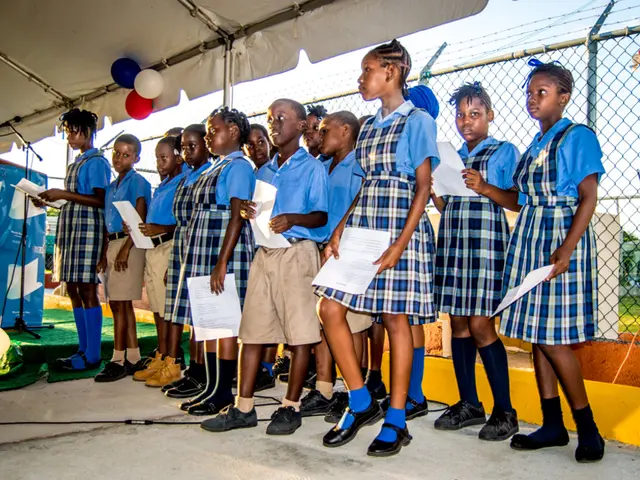Forced Matrimony's Aftermath: Examining the Societal Impact of Child Weddings
In Bangladesh, the issue of child marriage continues to be a significant concern, affecting countless lives and hindering the country's development. Latifa, a victim of child marriage, has faced numerous setbacks due to lack of financial resources and discrimination while seeking employment. She is not alone in her struggles, as many girls in similar situations face questions about their character and difficulty finding employment throughout their lives.
The problem is alarmingly prevalent in Bangladesh. According to recent statistics, around 71 out of every 1,000 girls aged between 15 and 19 have already become mothers. Marriage is responsible for around 42% of dropouts in Bangladesh, with 71% of female dropouts citing marriage as the reason for leaving school at a young age.
Fortunately, efforts are being made to combat child marriage and support its victims. The government, along with various NGOs, has launched initiatives to prevent child marriage and provide support to victims. This includes community engagement, expansion of crisis intervention services, and the establishment of One-Stop Crisis Centres (OCCs) and One-Stop Crisis Cells nationwide. These centres aim to build a community-based response to prevent violence, including child marriage.
Raising social awareness is another key strategy. Experts and organizations stress the importance of community involvement and mass campaigns to highlight the negative impacts of early marriage, particularly in rural and underprivileged areas where poverty and lack of extended education opportunities for girls contribute to high child marriage rates. UNICEF and UNFPA have renewed a multi-country initiative aimed at ending child marriage and protecting girls' rights, which supports social intervention and protection mechanisms.
Despite these efforts, the COVID-19 pandemic has exacerbated the issue of child marriage in Bangladesh. Increased poverty, disrupted education, and household stress have led to a rise in child marriage rates. This underscores the need for ongoing expansion of services, community engagement, and integrated social protection to fully address this issue.
Sadly, stories like Latifa's are all too common. Josna Khatun, married off at the age of 14, faced societal stigma and hardship after leaving her abusive marriage. She also faced sexual abuse and other forms of physical and mental abuse while working as a domestic worker in Saudi Arabia. Beauty Akhter, married off at the age of 12 to a man much older than her, experienced violence in her marriage. Her case serves as a cautionary tale about the societal stigma faced by those who leave abusive marriages.
Dr Soma Dey, a prominent figure in the fight against child marriage, emphasizes the need for preventing child marriage by addressing the factors that contribute to its occurrence, such as social security and poverty issues. She suggests ensuring proper implementation of existing laws to prevent child marriage and providing rehabilitation facilities for victims, including lifelong educational opportunities.
In conclusion, the issue of child marriage is a complex and persistent challenge in Bangladesh. However, with continued efforts, community engagement, and integrated social protection, it is possible to make significant strides in preventing child marriage and supporting its victims. Everyone has a role to play in this fight, and society should extend help to girls who want to leave child marriages and support those who want to start anew after a traumatic experience.
- Science has a role in understanding the root causes and effects of child marriage, informing evidence-based interventions.
- Workplace-wellness programs can provide resources and support for victims of child marriage, helping them to secure employment and build stability.
- Medical conditions, such as psoriasis and chronic diseases, can exacerbate the health challenges faced by child marriage victims.
- The importance of maintaining cardiovascular health cannot be overstated, especially for those who have experienced trauma due to child marriage.
- Respiratory conditions and digestive health issues are common among child marriage victims, often stemming from malnutrition and poor living conditions.
- Eye-health and hearing concerns can be particularly debilitating for child marriage victims, impacting their ability to work and communicate effectively.
- Health-and-wellness initiatives should prioritize family health, ensuring that children born into child marriages receive proper medical care and attention.
- Autoimmune disorders can be triggered by stress and trauma, making it essential to provide mental-health support for child marriage victims.
- Mens-health issues are often overlooked, but they are critical for fostering a healthy and supportive environment for child marriage victims.
- Skin-care products and treatments can help child marriage victims cope with the visible signs of their traumatic experiences.
- Therapies-and-treatments ranging from counseling to medical procedures can help child marriage victims overcome the physical and psychological scars left by their experiences.
- Womens-health concerns, such as reproductive health and menstrual hygiene, must be addressed for child marriage victims to have a chance at a healthy, productive life.
- Parenting education and resources are essential to help child marriage victims ensure their own children are not subjected to the same mistreatment they suffered.
- Climate change poses a threat to global health and wellness, including child marriage victims, as it can contribute to poverty, disrupted education, and household stress.
- Mental-health conditions, such as depression and anxiety, are common among child marriage victims and require specialized treatment and support.
- CBD, a compound found in cannabis, has shown potential in treating various mental-health conditions, offering hope for child marriage victims.
- Neurological-disorders can have a profound impact on child marriage victims, affecting their cognitive abilities and overall health.
- Environmental-science research can help identify the factors contributing to high child marriage rates, informing policies and interventions to combat the practice.
- Finance plays a critical role in addressing child marriage, as financial resources are crucial for empowering victims to rebuild their lives and secure their futures.
- Personal-finance skills training is essential for child marriage victims, equipping them with the tools to manage their money effectively and achieve financial stability.
- Data-and-cloud-computing technologies can help monitor and analyze child marriage rates, enabling targeted interventions to address the issue more effectively.
- Technology can provide child marriage victims with access to resources, support networks, and education opportunities, fostering their personal growth and development.
- Relationships with friends, family, and support networks are crucial for child marriage victims, offering emotional support and resources for rebuilding their lives.
- Books on topics such as self-development, self-help, and women's empowerment can help child marriage victims reclaim their lives and grow as individuals.
- Education-and-self-development programs can provide child marriage victims with opportunities to learn new skills and gain confidence, fostering their personal growth and independence.
- Social-media platforms can help child marriage victims connect with support networks and resources, raising awareness and fostering change.
- Career-development programs and job-search resources can help child marriage victims secure employment and build stable, prosperous lives for themselves and their families.







